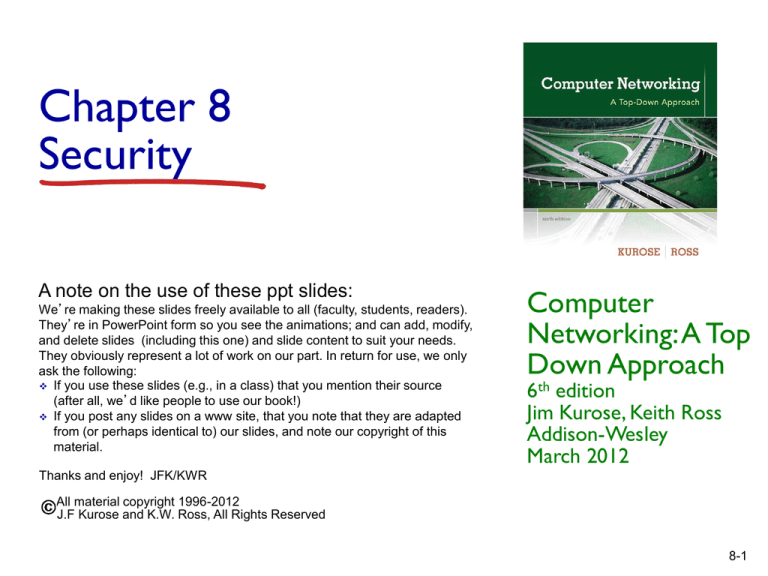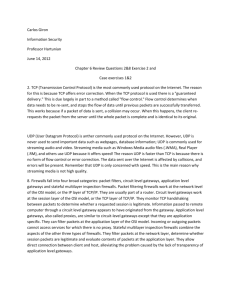
Chapter 8
Security
A note on the use of these ppt slides:
We’re making these slides freely available to all (faculty, students, readers).
They’re in PowerPoint form so you see the animations; and can add, modify,
and delete slides (including this one) and slide content to suit your needs.
They obviously represent a lot of work on our part. In return for use, we only
ask the following:
If you use these slides (e.g., in a class) that you mention their source
(after all, we’d like people to use our book!)
If you post any slides on a www site, that you note that they are adapted
from (or perhaps identical to) our slides, and note our copyright of this
material.
Computer
Networking: A Top
Down Approach
6th edition
Jim Kurose, Keith Ross
Addison-Wesley
March 2012
Thanks and enjoy! JFK/KWR
All material copyright 1996-2012
J.F Kurose and K.W. Ross, All Rights Reserved
8-1
Chapter 8 roadmap
8.1 What is network security?
8.2 Principles of cryptography
8.3 Message integrity
8.4 Securing e-mail
8.5 Securing TCP connections: SSL
8.6 Network layer security: IPsec
8.7 Securing wireless LANs
8.8 Operational security: firewalls and IDS
Network Security
8-2
Firewalls
firewall
isolates organization’s internal net from larger Internet,
allowing some packets to pass, blocking others
public
Internet
administered
network
trusted “good guys”
firewall
untrusted “bad guys”
Network Security
8-3
Firewalls: why
prevent denial of service attacks:
SYN flooding: attacker establishes many bogus TCP
connections, no resources left for “real” connections
prevent illegal modification/access of internal data
e.g., attacker replaces CIA’s homepage with something else
allow only authorized access to inside network
set of authenticated users/hosts
three types of firewalls:
stateless packet filters
stateful packet filters
application gateways
Network Security
8-4
Stateless packet filtering
Should arriving
packet be allowed in?
Departing packet let
out?
internal network connected to Internet via router firewall
router filters packet-by-packet, decision to forward/drop
packet based on:
source IP address, destination IP address
TCP/UDP source and destination port numbers
ICMP message type
TCP SYN and ACK bits
Network Security
8-5
Stateless packet filtering: example
example 1: block incoming and outgoing datagrams with
IP protocol field = 17 and with either source or dest
port = 23
result: all incoming, outgoing UDP flows and telnet
connections are blocked
example 2: block inbound TCP segments with ACK=0.
result: prevents external clients from making TCP
connections with internal clients, but allows internal
clients to connect to outside.
Network Security
8-6
Stateless packet filtering: more examples
Policy
Firewall Setting
No outside Web access.
Drop all outgoing packets to any IP
address, port 80
No incoming TCP connections,
except those for institution’s
public Web server only.
Drop all incoming TCP SYN packets
to any IP except 130.207.244.203,
port 80
Prevent Web-radios from eating
up the available bandwidth.
Drop all incoming UDP packets except DNS and router broadcasts.
Prevent your network from being
used for a smurf DoS attack.
Drop all ICMP packets going to a
“broadcast” address (e.g.
130.207.255.255).
Prevent your network from being
tracerouted
Drop all outgoing ICMP TTL expired
traffic
Network Security
8-7
Access Control Lists
ACL: table of rules, applied top to bottom to incoming
packets: (action, condition) pairs
action
source
address
dest
address
allow
222.22/16
outside of
222.22/16
allow
outside of
222.22/16
222.22/16
outside of
222.22/16
allow
222.22/16
allow
outside of
222.22/16
222.22/16
deny
all
all
protocol
source
port
dest
port
flag
bit
TCP
> 1023
80
TCP
80
> 1023
ACK
UDP
> 1023
53
---
UDP
53
> 1023
----
all
all
all
all
any
Network Security
8-8
Stateful packet filtering
stateless packet filter: heavy handed tool
admits packets that “make no sense,” e.g., dest port =
80, ACK bit set, even though no TCP connection
established:
action
allow
source
address
dest
address
outside of
222.22/16
222.22/16
protocol
source
port
dest
port
flag
bit
TCP
80
> 1023
ACK
stateful packet filter: track status of every TCP connection
track connection setup (SYN), teardown (FIN): determine
whether incoming, outgoing packets “makes sense”
timeout inactive connections at firewall: no longer admit
packets
Network Security
8-9
Stateful packet filtering
ACL augmented to indicate need to check connection
state table before admitting packet
action
source
address
dest
address
proto
source
port
dest
port
allow
222.22/16
outside of
222.22/16
TCP
> 1023
80
allow
outside of
222.22/16
TCP
80
> 1023
ACK
allow
222.22/16
UDP
> 1023
53
---
allow
outside of
222.22/16
222.22/16
UDP
53
> 1023
----
deny
all
all
all
all
all
all
222.22/16
outside of
222.22/16
flag
bit
check
conxion
any
x
x
Network Security
8-10
Application gateways
filter packets on
application data as well as
on IP/TCP/UDP fields.
example: allow select
internal users to telnet
outside
host-to-gateway
telnet session
application
gateway
router and filter
gateway-to-remote
host telnet session
1. require all telnet users to telnet through gateway.
2. for authorized users, gateway sets up telnet connection to
dest host. Gateway relays data between 2 connections
3. router filter blocks all telnet connections not originating
from gateway.
Network Security
8-11
Limitations of firewalls, gateways
IP spoofing: router can’t
know if data “really”
comes from claimed
source
if multiple app’s. need
special treatment, each has
own app. gateway
client software must know
how to contact gateway.
e.g., must set IP
address of proxy in
Web browser
filters often use all or
nothing policy for UDP
tradeoff: degree of
communication with
outside world, level of
security
many highly protected
sites still suffer from
attacks
Network Security
8-12
Intrusion detection systems
packet filtering:
operates on TCP/IP headers only
no correlation check among sessions
IDS: intrusion detection system
deep packet inspection: look at packet contents (e.g.,
check character strings in packet against database of
known virus, attack strings)
examine correlation among multiple packets
• port scanning
• network mapping
• DoS attack
Network Security
8-13
Intrusion detection systems
multiple IDSs: different types of checking at
different locations
firewall
internal
network
IDS
sensors
Internet
Web
DNS
server FTP server
server
demilitarized
zone
Network Security
8-14
IDS limitations
Q: Why not just use an IDS if it is superior to a
firewall?
A: Chance of missed packets
IDSs analyzes Layer-7
Computationally-expensive
If overloaded, IDSs will let packets pass without analysis
Network Security
8-15
Tradespace: Thoroughness vs. Speed
Stateful/Stateless Firewall
• Layer 4
• Inspects all packets
Application Gateway
• Layer 7
• Inspects all packets
belonging to one application
IDS
• Layer 7
• Skips packets if overloaded
Network Security
8-16
Intrusion prevention systems
IPS is like a combination IDS plus Firewall:
Analyzes up to Layer-7, like an IDS
Can drop packets like a Firewall
Network Security
8-17
Comparison
IPS is like a combination IDS plus Firewall:
Analyzes up to Layer-7, like an IDS
Can drop packets like a Firewall
Firewall
IDS
IPS
Layer-3 filters (IP)
Yes
Yes
Yes
Layer-4 filters (port)
Yes
Yes
Yes
Yes
Yes
Layer-7 filters (app)
Drop packets on match?
Skip packets if overloaded?
Yes
Yes
Yes
Yes
Network Security
8-18









